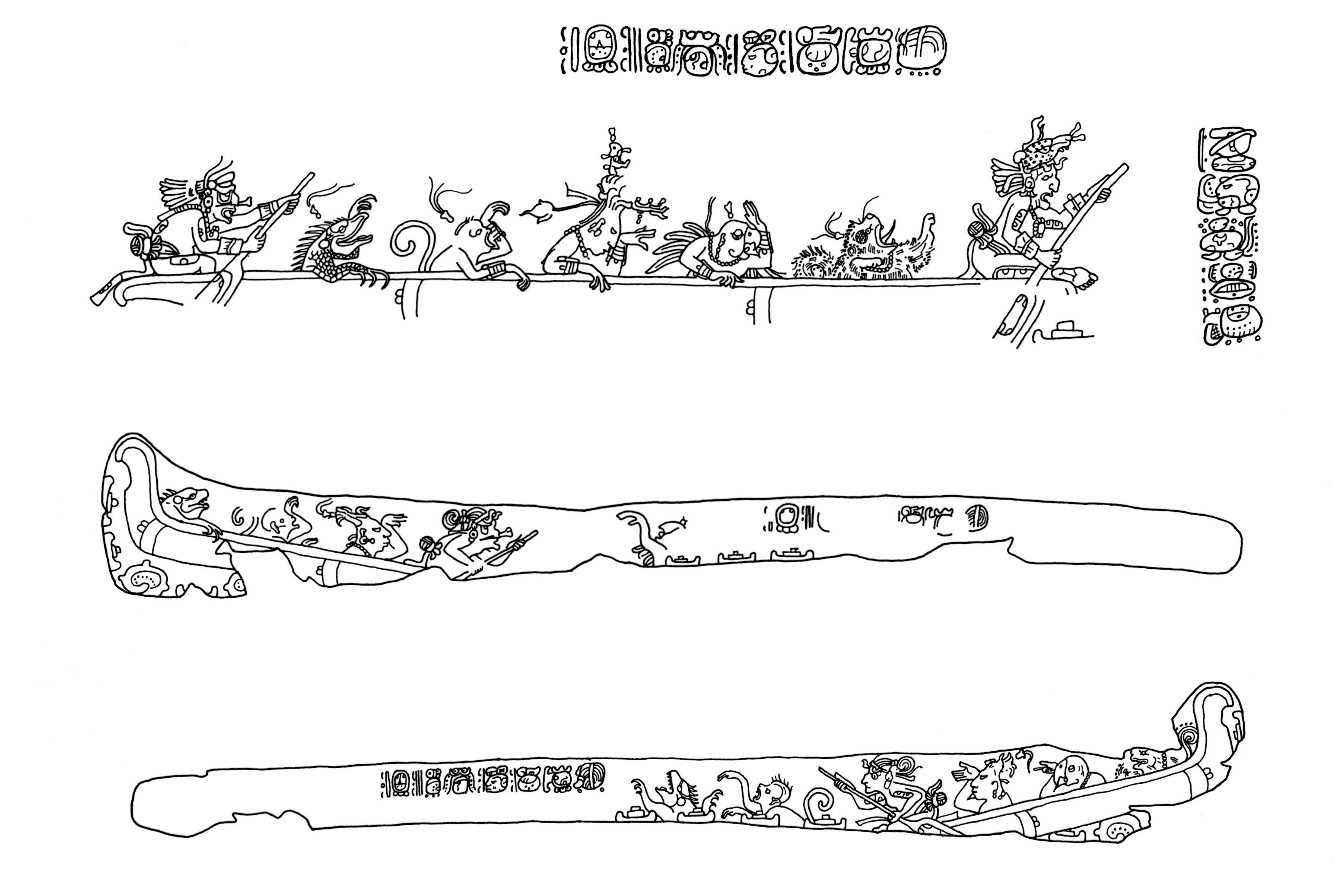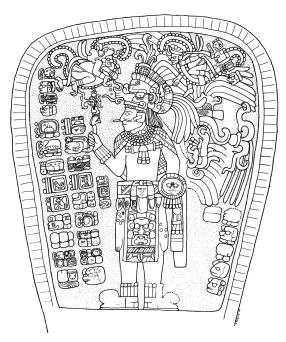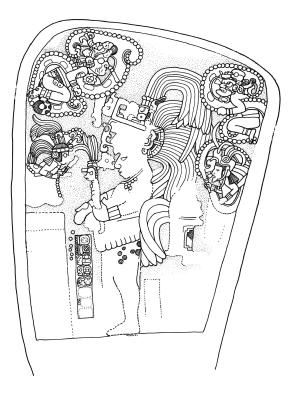 |
| Tikal Bones from Burial 116 Drawings by Linda Schele Courtesy of FAMSI |
The “Paddler Gods” first identified by Mathews (2001:394) are paired deities seen often ferrying gods in a dugout canoe. The portrait heads of each aged god bear wrinkled jowls, jutting toothless jaws. The “Jaguar Paddler” displays the ear, canine and spots of a jaguar and the “Stingray Paddler” wears a pierced bone (stingray spine) through the septum of his nose (Mathews 2001:394). Variant logographs night (AK’AB) and day (K’IN) substitute for their respective names (Villela 1991) revealing their dualistic nature representing night and day. Their role as paddlers are best known from Tikal Burial 116 bones MT38a and MT38b that show them at the bow and stern of a boat transporting a deceased Maize god through the underworld waters (Stone and Zender 2011:51). Yet, they are also depicted on various ceramics as the boatmen who carry the Maize God to his place of rebirth (Quenon and Le Fort1997).
 |
| Kerr Vase 3033 Photo by Justin Kerr Courtesy of mayavase.com |
 |
| Jimbal Stela 1 Drawing by Linda Schele Courtesy of FAMSI |
 |
| Ixlu Stela 2 Drawing by Linda Schele Courtesy of FAMSI |
 |
| The Jaguar Paddler God from Ixlu Stela 2. Photo by Carl Callaway 2010. |
The Stingray Paddler God from Ixlu Stela 2. Photo by Carl Callaway 2010.
Finally on Quirigua Zoomorph G, East side (N2) the “Paddler Gods” carry the MUYAL-li cloud logograph (a neat head variant of the sign) in their title reinforcing the cloud/mist connection.
 |
| Quirigua Zoomorph G Initial Text, Blocks A-P Drawing by Matthew Looper |
On era day 13.0.0.0.0 4 Ajaw 8 Kumk'u, these gods are related to three actions: Quirigua Stela C records that they erect the first of three stones in a sacred locale named NAH JO’ CHAN “JAGUAR THRONE”; Piedras Negras Altar 1 associates them directly to the “changing of the altar/pedestal” event; while “Tila” Stela A relates the pair to a possible “bathing” event.
Works Cited
Mathews, Peter
2001(1977) The Inscription on the Back of Stela 8, Dos Pilas, Guatemala. In: TheDecipherment of Maya Hieroglyphic Writing, edited by S. D. Houston, D. Stuart, and O. Chinchilla M., pp. 394-415. Norman, University of Oklahoma Press.
Quenon, Michel, and Genevieve Le Fort
1997 Rebirth And Resurrection In Maize God Iconography. In: The Maya Vase Book: Vol. 5, Justin Kerr and Barbara Kerr (eds.), pp. 884–902. New York: Kerr & Associates.
Stone, Andrea, and Mark Zender
2011 Reading Maya Art. London: Thames and Hudson Ltd.
Stuart, David, Stephen Houston, and John Robertson
1999 Recovering the Past: Classic Maya Language and Classic Maya Gods. In: Notebook for the XXIIIrd Maya Hieroglyphic Forum at Texas. Austin: Texas.
Villela, Khristaan D
1991 Early Notices on the Maya Paddler Gods. In: Texas Notes on Precolumbian Art, Writing, and Culture, 17, University of Texas at Austin. Austin : Center of the History and Art of Ancient American Culture.


No comments:
Post a Comment